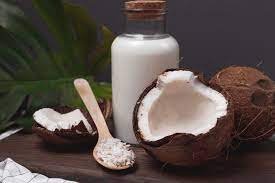Recipe credit: Darshana Muzumdar
Makes 1 litre combined first and second extract of coconut milk
Coconut milk was traditionally used in many sweet preparations like kheers, payasams and barfis but was slowly replaced by dairy milk after the white revolution. It can be used as a substitute for dairy milk in most dishes, however it tends to split if boiled for too long. So, try heating it instead of boiling it. In any case, even if it splits, it tastes fine and one cannot feel the solids as in split dairy milk.
One coconut usually weighs anywhere from 200gms to 450gms. The following recipe is for a medium sized coconut of around 350 gms. One coconut or two cups of grated coconut plus two cups of water will yield around 500 ml of thick coconut milk. The residue plus one cup water will yield around 300-400 ml thin coconut milk of the second extract.
The general rule for the first extract is to just about cover the coconut pieces or the scraped coconut with just enough water for the blades of the blender to move smoothly to get the first extract. Or use 1 cup water for each 1 cup of coconut pieces or grated coconut to get the first thick extract.
Coconut milk can be preserved in an airtight container in the fridge for around 2-3 days. However it’s always best to use freshly made coconut milk for the best flavor.
Ingredients
- 1 medium size coconut
- 3 cups water
Method
Breaking the coconut:
- Remove the top husk on the coconut.
- Wash the coconut and keep aside for the water to drain and till the shell is fairly dry or wipe it with a napkin. Washing prevents the outside fibers from falling into the coconut water when you break it.
- Break the coconut into two with a hammer, coconut breaking sickle, or a strong metal pestle.
Making the coconut milk
- Either remove the coconut flesh with a knife or scrape it on the traditional South Indian scraper. If the pieces have been removed with a knife, cut them into thinner slivers or smaller pieces to ensure the blender doesn’t get damaged.
- Measure the pieces or grated coconut in cups. It should be around 2 cups. Add just about enough boiling water to cover the grated coconut or use 1 cup of hot water for each cup of grated coconut. Cover and keep aside for 5-10 minutes till it cools enough to use in a blender. Note: Soaking in hot water helps to get a finer consistency after grinding.
- If you do not want to soak it, place 1 cup slivers or grated coconut into the jar of a blender. Add one cup of water.
- Blend till very fine. Add a little more water if the mixture doesn’t move smoothly in the jar.
- Strain through a fine muslin cloth or nut milk bag placed over a pot. Squeeze out as much milk as possible. Keep the strained leftovers in a bowl to remove the second extract later.
- Repeat with the rest of the coconut slivers or grated coconut. This is the first thick extract.
- Put this first extract away in a steel pot or a glass jar. This can last for up to 3 days if refrigerated, however, it may split more easily if used in curries or any hot drink.
- Put the fiber in the bowl back into the jar again and add 3/4 cup water. Grind to a fine paste again for about two minutes. Add a little more of water if necessary.
- Strain and keep aside. This is the second thinner extract. Keep this aside separately in a steel pot or glass jar.
- Repeat with the fibre left in the muslin cloth once again. This time use only half cup of water. This will be the third very thin extract.
For the Whole-Food Plant-Based (WFPB) version:
Very often finely ground coconut can be used without straining it. This is especially good in curries and sweet dishes.






Share this:
- Click to share on Facebook (Opens in new window)
- Click to share on WhatsApp (Opens in new window)
- Click to share on Twitter (Opens in new window)
- Click to share on Pinterest (Opens in new window)
- Click to share on LinkedIn (Opens in new window)
- Click to share on Reddit (Opens in new window)
- Click to share on Tumblr (Opens in new window)
- Click to share on Pocket (Opens in new window)
- Click to share on Telegram (Opens in new window)
- Click to print (Opens in new window)

